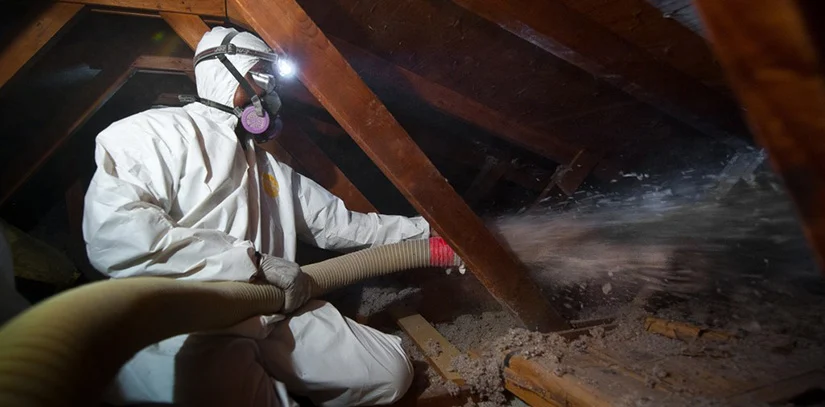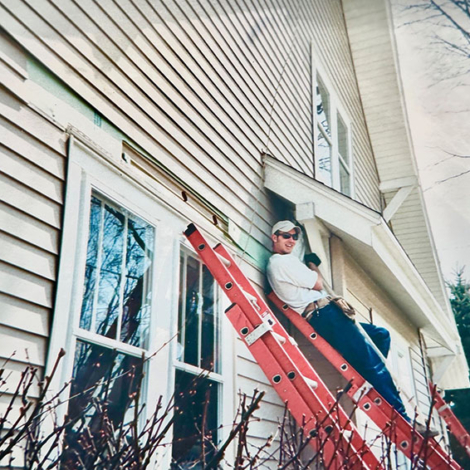
A weatherization technician blows loose-fill cellulose insulation to increase the R-value of an unfloored attic. Photo: Dennis Schroeder / NREL (used with permission)
Renovating our homes to improve energy efficiency will be necessary if we plan to reach our global climate goals, but some of these energy retrofits can have an unintended consequence. Retrofits that insulate our homes to regulate indoor temperatures can also trap airborne pollutants inside, where we spend most of our time. There is a solution, however, in improved ventilation.
The built environment is responsible for nearly 40 percent of global energy use, and the sector is a heavy contributor to greenhouse gas emissions. While new buildings can be built sustainably and their indoor spaces can have good air quality, the existing building stock may need attention. In the drive toward a sustainable future, major energy retrofitting will be required to improve energy efficiency, especially in residential buildings, within the next decade.
Retrofits of existing buildings can take many forms. Those that modify the building’s fabric insulation are commonly called ‘weatherization retrofits’ in the United States and ‘building envelope retrofits’ in Europe. Other renovations can include upgrades to ventilation systems, installation of heat pumps and simple modifications to windows and doors. Energy retrofits can be classified as ‘deep’ or ‘shallow.’ Deep energy retrofits entail a detailed renovation plan that aims to reduce energy consumption by 70 percent or greater, while shallow energy retrofits aim for an energy reduction of 30 percent or less.
Indoor air quality is no trade-off
Research has shown that these retrofits can reduce indoor air quality. We spend about 80-90 percent of our time indoors, and most of that time is in our homes. The air quality at home is paramount, and an energy renovation should not decrease it.
What makes indoor air unhealthy? Research points to several sources of contamination. Those include certain cleaning products, cooking styles and the stoves we use to cook food, decorative materials such as candles and incense, activities such as smoking and many others. Outdoor air can also contaminate the air indoors when it slips inside, especially in urban areas with dense populations and industry.
Dr. Lindsay Underhill at Boston University and her team published a study in 2020 on air quality and health impacts following energy-efficiency retrofits. Their research suggests retrofits can lead to an increase in indoor air contaminants if they exclude modifications to ventilation. Retrofits can take a financial toll on property owners, leading some to skip ventilation improvements. While financial assistance programs can cover the cost of retrofits, they often exclude improvements to ventilation systems required for good air quality, the study concludes.
Developing a decision-support tool
Residential retrofits should consider several factors: The geographical location, climate, the type of dwelling (e.g. bungalow, apartment, semi-detached, etc.), physical location of the house (urban, rural, semi-urban, etc.), single/multifamily and occupancy-related information. Each scenario can undergo a variety of energy renovations.
Through my research as a part of the team carrying out Project “ENABLE” (Enabling interdisciplinary analysis for whole life-cycle residential renovation), I am helping develop a decision-support tool to aid stakeholders. The tool guides the selection of the most appropriate energy renovation strategy for a given residential building without compromising indoor air quality. In simple terms, we are looking into how we can make our existing homes more energy efficient and healthier without overspending.
Decarbonizing the built environment requires a holistic strategy. That means balancing energy efficiency with appropriate indoor air quality at a justifiable cost.
About the Author
Buddila Wijeyesekera is a Mechanical Engineer specializing in Renewable and Sustainable Energy systems and a former Engineering for Change Fellow. He is pursuing a PhD focused on investigating the impacts of new energy retrofits on indoor air quality of residential dwellings at the University of Galway in Ireland.

